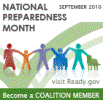
Emergency Physicians to Public: Prepare Now Before Disaster Strikes
Hurricane Earl, a Category 2 storm this morning, now poses little danger to the U.S. eastern seaboard. But the hurricane season isn't over, and other threats are out there.
Disasters can strike quickly and without warning. As part of National Preparedness Month, which officially began Sept. 1, the American College of Emergency Physicians once again urged the public to have a plan in place and know when to execute it if and when the time comes. Hurricane Earl is a Category 2 storm this morning, now posing little danger to the U.S. eastern seaboard. But the hurricane season isn't over, and other threats are out there.
"No one should ever be guessing in a time of crisis," said ACEP President Dr. Angela Gardner. "You may not be able to predict a disaster, but you can at least start to prepare for one just in case."
National Preparedness Month is held each September to encourage Americans to take simple steps to prepare for emergencies in their homes, businesses, and communities. The month is sponsored by the Ready campaign in partnership with Citizen Corps and The Advertising Council. Ready is a national public service advertising campaign designed to educate and empower Americans to prepare for and respond to emergencies, including natural disasters and potential terrorist attacks.
In 2009, nearly 2,700 organizations joined the Ready campaign. The public can join the preparedness effort at any time by following these steps:
- Get a Kit. An emergency kit includes the basics for survival: fresh water, food, clean air, and warmth. You should have enough supplies to survive for at least three days. Emergency supply lists can be found at www.ready.gov/america/_downloads/checklist.pdf and also at ACEP's Foundation website at www.emergencycareforyou.org/disastersupplykit.
- Make a Plan. Before an emergency happens, sit down with your family and decide how you will contact each other, where you will go and what you will do in an emergency. Family emergency plan templates can be found at www.ready.gov/america/_downloads/familyemergencyplan.pdf and also at www.emergencycareforyou.org/makeaplan.
- Be Informed. Check all types of media (websites, social media, TV, radio, newspapers, phones) for information. During an emergency, your local emergency management office will give you information on such things as open shelters and evacuation orders, if needed.
For more information on the Ready campaign, visit www.ready.gov (English site) and/or www.listo.gov (Spanish site).
ACEP recommends that families identify what types of disasters are common in their region. This information can be obtained from local emergency management offices or American Red Cross chapters.
"Even though a tornado differs from hurricanes, floods, earthquakes, or terrorist attacks, many of the ways to prepare are the same," Gardner said. "Preparing your family in advance is the best protection in an emergency."
For more information on what do to in the event of a disaster, go to www.EmergencyCareForYou.org.
ACEP is a national medical specialty society representing emergency medicine. ACEP is committed to advancing emergency care through continuing education, research and public education. Headquartered in Dallas, ACEP has 53 chapters representing each state, as well as Puerto Rico and the District of Columbia. A Government Services Chapter represents emergency physicians employed by military branches and other government agencies.